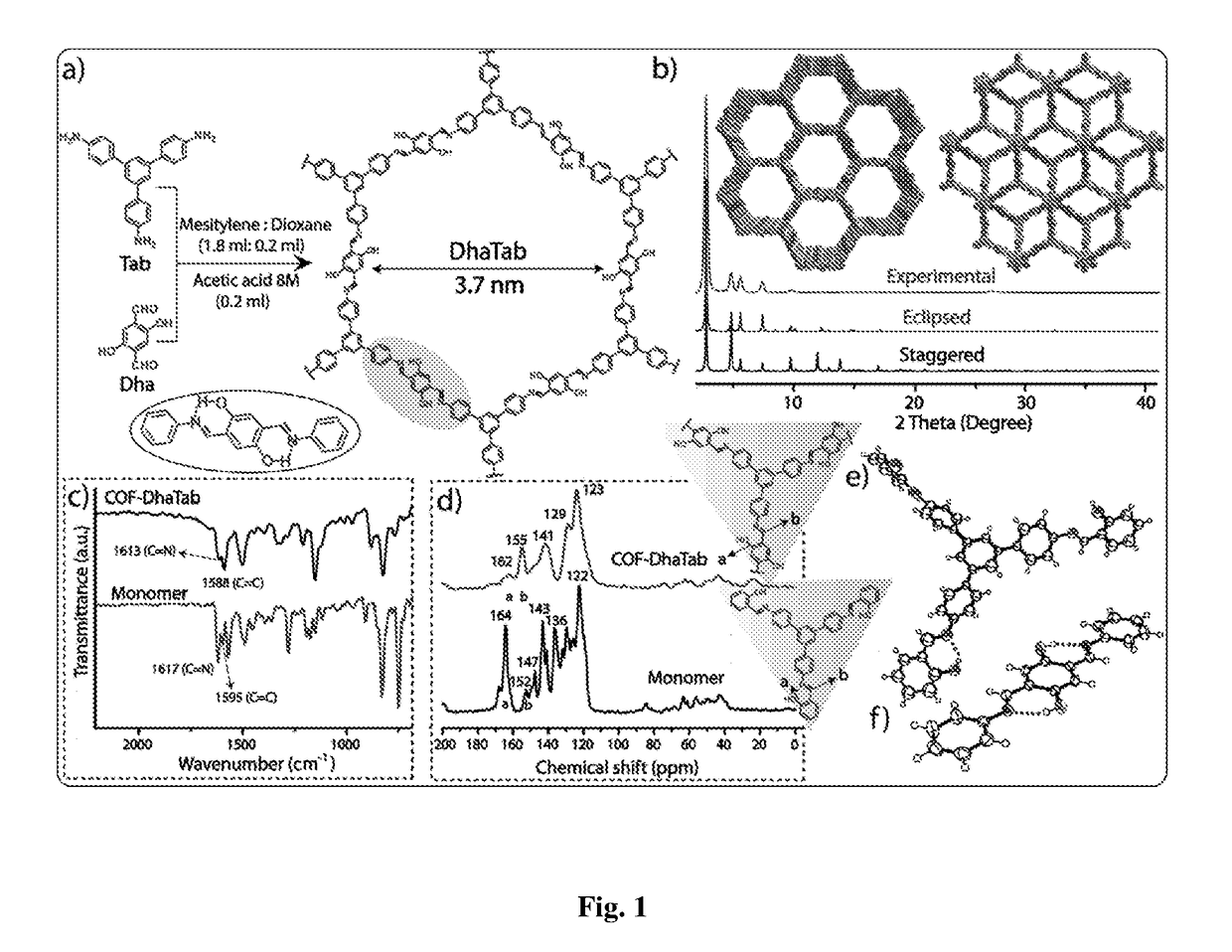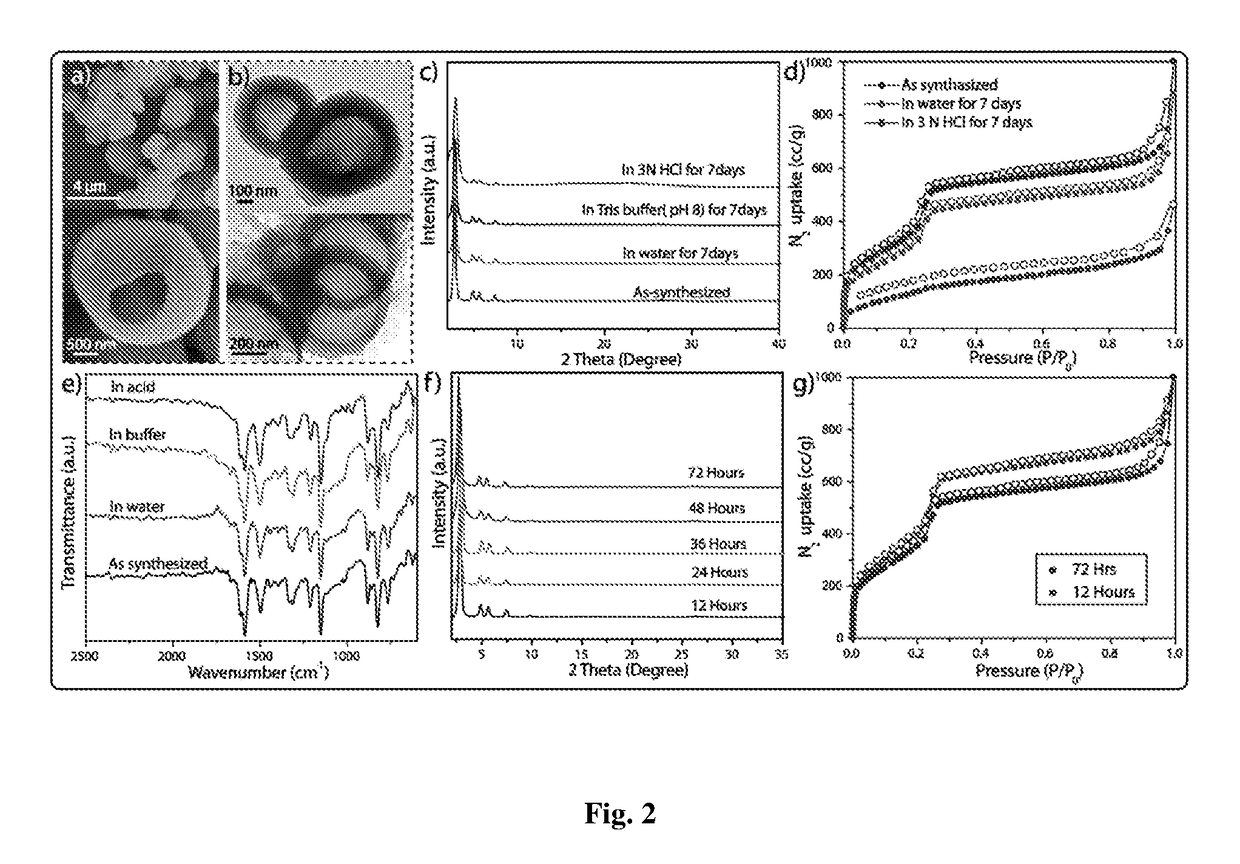Chemically stable hollow sperical cof and synthesis thereof
a hollow sperical and stable technology, applied in biochemistry apparatus and processes, peptidases, enzymes, etc., can solve the problems of difficult isolation of pure hollow spheres, insufficient understanding of cof crystallization and self-assembly mechanisms, and limited growth range of hollow spheres in nano/micro domains. achieve the effect of high surface area
- Summary
- Abstract
- Description
- Claims
- Application Information
AI Technical Summary
Benefits of technology
Problems solved by technology
Method used
Image
Examples
example 1
Material and Methods:
[0070]The hydroxyl aromatic component of the covalent organic framework i.e. 2,5-dihydroxyterephthalaldehyde (Dha) was synthesized by 1,4-dimethoxybenzene according to a previously published procedure by Kretz, T., Naturforsch. 62b, 66-74 (2007). Powder X-ray diffraction (PXRD) patterns were recorded on a Rigaku, MicroMax-007HF with high intensity Microfocus rotating anode X-ray generator. All the samples were recorded in the 2θ range of 2-40 degrees and data was collected with the help of Control Win software. A Rigaku, R-axis IV++ detector was employed in wide-angle experiments. The radiation used was CuK (1.54 Å) with a Ni filter, and the data collection was carried out using an Aluminium holder. Fourier transform infrared (FT-IR) spectra were taken on a Bruker Optics ALPHA-E spectrometer with a universal Zn—Se ATR (attenuated total reflection) accessory in the 600-4000 cm−1 region or using a Diamond ATR (Golden Gate). Thermo gravimetric analysis (TGA) were c...
example 2
[0071]Synthesis of hollow spherical COF-DhaTab:
[0072]Synthesis of COF-DhaTab was done by the Schiff base reaction between 2,5-dihydroxyterephthalaldehyde (Dha) (21.6 mg) and 1,3,5-tris(4-aminophenyl)benzene (Tab) (30.2 mg) in mesitylene-dioxane (1.7 mL: 0.3 mL) solvent combination and a catalytic amount of 0.2 mL 8 M acetic acid. The reactants and solvents were first charged in a pyrex tube (o.d.×i.d.=12×10 mm2 and length 18 cm) and then the mixture was sonicated for 10 minutes in order to get a homogeneous dispersion. The tube was flash frozen at 77 K (liquid N2 bath) and degassed by three freeze-pump-thaw cycles. The tube was then vacuum sealed and heated at 120° C. for 3 days. A yellow coloured fluffy powder was collected by centrifugation or filtration and washed with DMAc, water and ethanol. This yellow powder was dried at 150° C. under vacuum for 12 hours to get the corresponding COF in ˜80% isolated yield.
example 3
[0073]Synthesis of COF-DhaTab at different time intervals:
[0074]COF reaction tubes were removed from the oven at different intervals of time (12 h, 24 h, 36 h, 48 and 72 h). After reaching room temperature, the reaction tube was broken and COF powders were thoroughly washed with DMAc, water and ethanol to remove any unreacted starting materials or polymeric side products. The dry powdered samples of DhaTab were used as such for characterization with PXRD, TGA, FT-IR, etc. For TEM, SEM and AFM imaging, 1 mg of DhaTab in 5 mL of isopropanol was sonicated for 10 minutes and subsequently coated on the carbon-coated copper grid (TEM) and Si-wafer or mica (AFM), and dried at room temperature prior to imaging.
PUM
| Property | Measurement | Unit |
|---|---|---|
| Time | aaaaa | aaaaa |
| Time | aaaaa | aaaaa |
| Fraction | aaaaa | aaaaa |
Abstract
Description
Claims
Application Information
 Login to View More
Login to View More - R&D
- Intellectual Property
- Life Sciences
- Materials
- Tech Scout
- Unparalleled Data Quality
- Higher Quality Content
- 60% Fewer Hallucinations
Browse by: Latest US Patents, China's latest patents, Technical Efficacy Thesaurus, Application Domain, Technology Topic, Popular Technical Reports.
© 2025 PatSnap. All rights reserved.Legal|Privacy policy|Modern Slavery Act Transparency Statement|Sitemap|About US| Contact US: help@patsnap.com



